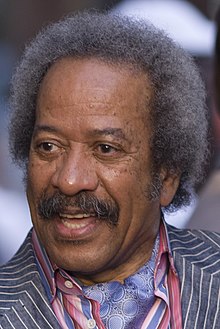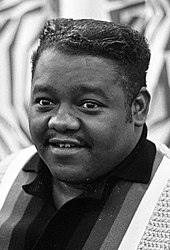
Rhythm and blues, frequently abbreviated as R&B or R'n'B, is a genre of popular music that originated in African-American communities in the 1940s. The term was originally used by record companies to describe recordings marketed predominantly to urban African Americans, at a time when "urbane, rocking, jazz based music ... [with a] heavy, insistent beat" was becoming more popular. In the commercial rhythm and blues music typical of the 1950s through the 1970s, the bands usually consisted of piano, one or two guitars, bass, drums, one or more saxophones, and sometimes background vocalists. R&B lyrical themes often encapsulate the African-American experience of pain and the quest for freedom and joy, as well as triumphs and failures in terms of relationships, economics, and aspirations.
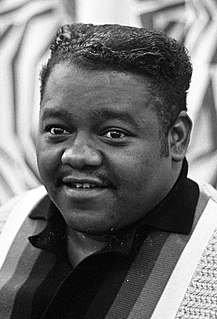
Antoine Dominique Domino Jr., known as Fats Domino, was an American pianist, singer and songwriter. One of the pioneers of rock and roll music, Domino sold more than 65 million records. Born in New Orleans to a French Creole family, Domino signed to Imperial Records in 1949. His first single "The Fat Man" is cited by some historians as the first rock and roll single and the first to sell more than 1 million copies. Domino continued to work with the song's co-writer Dave Bartholomew, contributing his distinctive rolling piano style to Lloyd Price's "Lawdy Miss Clawdy" (1952) and scoring a string of mainstream hits beginning with "Ain't That a Shame" (1955). Between 1955 and 1960, he had eleven Top 10 US pop hits. By 1955, five of his records had sold more than a million copies, being certified gold.
Willie Hall, best known by his nickname Drive 'Em Down, was a New Orleans blues and boogie woogie piano player. He never recorded, but has had a great influence on blues and rock and roll.

De Luxe Records was a record company and label formed in 1944 by brothers David Braun (1908–1985) and Julius "Jules" Braun (1911–2002), the sons of Hungarian Jewish immigrants, in Linden, New Jersey. The label flourished in the 1940s and 1950s, notably for its rhythm and blues (R&B) and early rock and roll recordings.

David Louis Bartholomew was an American musician, bandleader, composer, arranger, and record producer. He was prominent in the music of New Orleans throughout the second half of the 20th century. Originally a trumpeter, he was active in many musical genres, including rhythm and blues, big band, swing music, rock and roll, New Orleans jazz, and Dixieland. In his induction into the Rock and Roll Hall of Fame, he was cited as a key figure in the transition from jump blues and swing to R&B and as "one of the Crescent City's greatest musicians and a true pioneer in the rock and roll revolution".

Overton Amos Lemons, known as Smiley Lewis, was an American New Orleans rhythm and blues singer and guitarist. The music journalist Tony Russell wrote that "Lewis was the unluckiest man in New Orleans. He hit on a formula for slow-rocking, small-band numbers like 'The Bells Are Ringing' and 'I Hear You Knocking' only to have Fats Domino come up behind him with similar music with a more ingratiating delivery. Lewis was practically drowned in Domino's backwash."
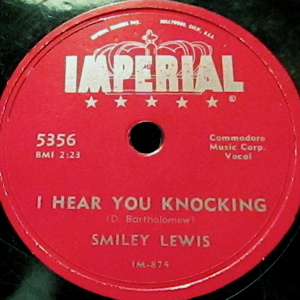
"I Hear You Knocking" is a rhythm and blues song written by Dave Bartholomew. New Orleans rhythm and blues singer Smiley Lewis first recorded the song in 1955. The lyrics tell of the return of a former lover who is rebuffed.
Thaddeus Bunol "Tad" Jones was an American music historian and researcher. His extensive research is credited with definitively establishing and documenting Louis Armstrong's correct birth date, August 4, 1901.

Alvin Owen "Red" Tyler was an American R&B and neo-bop jazz saxophonist, composer and arranger, regarded as "one of the most important figures in New Orleans R&B".
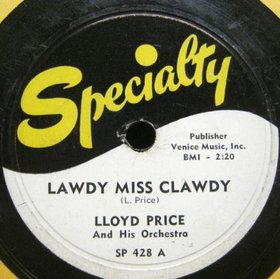
"Lawdy Miss Clawdy" is a song by New Orleans singer/songwriter Lloyd Price that "grandly introduced The New Orleans Sound". It was first recorded by Price in 1952 with Fats Domino and Dave Bartholomew during his first session for Art Rupe and Specialty Records. The song became one of the biggest selling R&B records of 1952 and crossed over to other audiences. "Lawdy Miss Clawdy" inspired many songs and has been recorded by a variety of artists.

Herbert Hardesty was an American musician who played tenor saxophone and trumpet. He is best known for his association with the New Orleans pianist Fats Domino and the producer Dave Bartholomew, beginning in 1948. He released six 45-rpm records as Herb Hardesty between 1959 and 1962. His first CD of these recordings, together with others made but not issued in 1958, were released worldwide in July 2012 by Ace Records as The Domino Effect.
Annie Laurie was an American jump blues and rhythm and blues singer. She is most associated with the bandleader and songwriter, Paul Gayten, although she also registered hit singles in her own name. Laurie first recorded in the mid-1940s and her professional career lasted until the early 1960s. Appraisal of her qualities appear to vary between Dinah Washington stating that Laurie was her favorite singer, to Irma Thomas, who opined - "Annie Laurie? She was okay."
Lewis Robert Chudd was an American record label and radio executive who founded Imperial Records in 1946. The record company was influential in the development of rock and roll, with a roster of musicians including Fats Domino, Slim Whitman, Chris Kenner, Sandy Nelson, and Ricky Nelson.
Frank Nomer Fields was an American double bass player who was involved in many R&B, rock and roll and jazz recordings made in New Orleans.
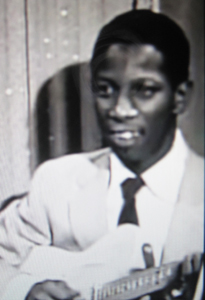
Walter Charles Nelson Jr., known as Walter "Papoose" Nelson, was an American R&B guitarist, best known for playing with Fats Domino, and on many of his hit records.

John Mortimer Boudreaux, Jr. was an American drummer who was active in jazz, soul, and rhythm & blues idioms.

Mary Jewel King was an American rhythm and blues singer in New Orleans.
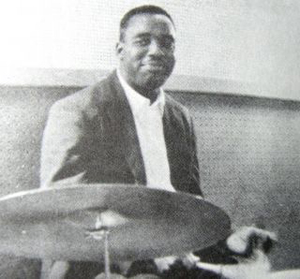
Charles "Hungry" Williams was an American Rhythm & Blues drummer, best known for the innovative and influential technique he used on numerous recordings that came out of New Orleans in the 1950s and '60s.

Cornelius Jessie Coleman, also called "Tenoo", was an American R&B drummer best known for playing with Fats Domino's band and on many of his hit records.

Walter Daniel Lastie, also known as "Popee", was an American rhythm & blues and jazz drummer from the musical Lastie family who played and recorded with many of New Orleans' leading R&B musicians.
